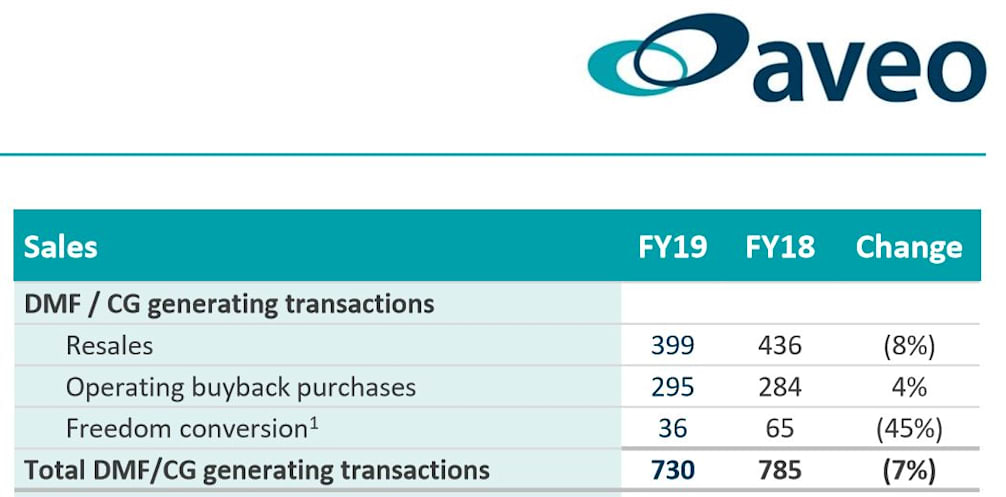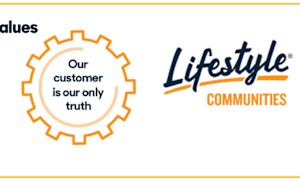Aveo released its FY19 results last week; they were a case study in the knock-on effect of slow sales.
The company has declared a statutory loss after tax of $213M, a negative change of 158% compared to the $365M profit for FY18.
Aveo states this decrease of $259M was “largely due to the investment property valuation of the retirement portfolio. This was on the back of a review of the retirement portfolios unit pricing and the adoption of lower property price growth assumptions used in determining the value of the portfolio, reflecting the downturn in the broader residential property market across Australia over the past two years”.
Sales and settlements
The real value of all retirement village businesses is anchored on sales (achieving a deposit) and settlements (committed incoming residents selling their family home to generate cash for the retirement village home).
Aveo CEO Geoff Grady says, “a key metric looking forward relates to the ratio of seen appointments to written sales. This ratio continues to strengthen throughout FY 19 with our written conversion rate at an all-time high of ~29% in the fourth quarter of the period, compared to less than 17% the year earlier”.
April to June they achieved an average of 210 leads every week, 80 inspections and 23 written contracts.
Settlements remains the challenge caused by slow sales of the family home by incoming residents.
In today’s market every operator must concentrate on the generation of an exponentially larger volume of leads to ensure there is an equal volume of people attempting to sell their homes.
The pleasure and the pain of the retirement village model, is it naturally generates turnover of stock, as residents age and leave the village.
The Aveo figures demonstrate the downside of this model and the slow market.
The inbuilt supply side of retirement villages
- Aveo’s average occupancy of independent living units is 10 years; they have 9,111 ILUs, meaning 911 become vacant each year.
- They have 3,008 serviced apartments with an average occupancy of four years, meaning 752 become available every 12 months.
- Total new vacancies: 1,663 new homes to sell over the year.
- They took deposits on 1,150 homes but settled 901, a shortfall of 762 homes on the number of homes available, approximately the same number as FY18.
With an average DMF/development profit of $120,000, they are missing over $90M net a year.
And villages with a large number of vacancies can quickly get a negative ‘local’ reputation. Their occupancy is now down to 87%, from 90% last year.
With new regulations requiring buy backs, Aveo has had to make 213 ‘mandated’ buy backs, but after sales efforts they were left holding 125 buy backs as June 30.
Sales solve all problems - profit and regulations
As Geoff Grady stated, the key metric is increasing the volume of leads and the trickle down to written sales and settlements.
Increase the leads, increase settlements, deliver cash.
As important as the cash is, it impacts on ‘trust’ in retirement villages and the future of the sector.
Customers are impacted too. When residents and their families see that their village home is vacant in a village with growing vacancies, belief in the product and reputation of villages is damaged, further impacting sales and values.
This brings negative media and regulations as well. As one prominent resident said to me yesterday,
“The (6 month) buy backs (in NSW) is the incentive to get operators off their backsides and sell properties faster”.
Buy backs are not a problem if village homes are sold within the six months.
But are villages still relevant to today’s customer
Yes. Retirement villages offer security and contentment in our later years. Aveo is generating 225 enquiries every week by people who are challenged with living in their family home. At villages.com.au we have 25,000 visits every week by people considering retirement villages.
And the Aveo statistics back this up.
The average age of entry into an Aveo ILU is 76.5. Given most new residents enter as a couple, with one member passing away or requiring residential aged care, the average resident length of stay is 7.9 years but the average length of stay of the remaining resident is 9.7 years.
Not only are couples provided the community and security in the later years, their later years are significantly longer than the average for Australia.
Remembering that residents join a village because they identify they have a need – physical, emotional or financial — one would expect that at least one member of the couple is a challenge.
Today the average age of death is 80.5 years for men and 84.6 years for women.
In Aveo villages the average age of ILU residents is 82.4 years and serviced apartment residents is 87.4 years.
This compares to the average age of residents in aged care homes of 81.
Last Aveo report
This is likely the last time that we will have access to Aveo’s detailed business metrics with the pending purchase by Brookfield. This is unfortunate because Aveo has been the only reliable source of this information. No other operator gives this level of detail.
Without data like this the sector is weak in its representations to government and the community generally.










